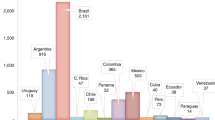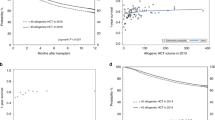Abstract
The use of hematopoietic cell transplantation (HCT) has risen in recent years and additional increases are projected in the near- and long-term future. The complex nature of HCT, along with its potentially rigorous follow-up care requirements, presents numerous potential barriers to accessing this important service (for example, financial considerations, donor availability and sociodemographic factors). The distance between a patient and an HCT facility also appears to be an important factor in both HCT use and outcomes. We provide the first comprehensive and detailed evaluation of geographic access to HCT services for the adult (18+ years) and pediatric (0–17 years) populations in the United States. Population-level access is examined as well as detailed gender, race/ethnicity and age breakdowns. Generally, access to HCT services appears to be quite high throughout the United States, as 48%, 78.6% and 94.7% of the 18+ years age population has 30, 90 and 180 min access (respectively) to an adult HCT facility and 42.5%, 72% and 91.5% of the 0–17 years age population has 30, 90 and 180 min access (respectively) to a pediatric facility.
This is a preview of subscription content, access via your institution
Access options
Subscribe to this journal
Receive 12 print issues and online access
$259.00 per year
only $21.58 per issue
Buy this article
- Purchase on Springer Link
- Instant access to full article PDF
Prices may be subject to local taxes which are calculated during checkout





Similar content being viewed by others
References
Majhail NS, Murphy EA, Denzen EM, Ferguson SS, Anasetti C, Bracey A et al. The National Marrow Donor Program’s Symposium on Hematopoietic Cell Transplantation in 2020: A Health Care Resource and Infrastructure Assessment. Biol Blood Marrow Transplant 2012; 18: 172–182.
Majhail NS, Tao L, Bredeson C, Davies S, Dehn J, Gajewski JL et al. Prevalence of hematopoietic cell transplant survivors in the United States. Biol Blood Marrow Transplant 2013; 19: 1498–1501.
Majhail NS, Mau L-W, Chitphakdithai P, Payton T, Eckrich M, Joffe S et al. National survey of hematopoietic cell transplantation center personnel, infrastructure, and models of care delivery. Biol Blood Marrow Transplant 2015; 21: 1308–1314.
Majhail NS, Murphy EA, Omondi NA, Robinett P, Gajewski JL, LeMaistre CF et al. Allogeneic transplant physician and center capacity in the United States. Biol Blood Marrow Transplant 2011; 17: 956–961.
Majhail NS, Omondi NA, Denzen E, Murphy EA, Rizzo JD . Access to hematopoietic cell transplantation in the United States. Biol Blood Marrow Transplant 2010; 16: 1070–1075.
Abou-Nassar KE, Kim HT, Blossom J, Ho VT, Soiffer RJ, Cutler CS et al. The impact of geographic proximity to transplant center on outcomes after allogeneic hematopoietic stem cell transplantation. Biol Blood Marrow Transplant 2012; 18: 708–715.
Rao K, Darrington DL, Schumacher JJ, Devetten M, Vose JM, Loberiza FR Jr . Disparity in survival outcome after hematopoietic stem cell transplantation for hematologic malignancies according to area of primary residence. Biol Blood Marrow Transplant 2007; 13: 1508–1514.
Paulson K, Lambert P, Bredeson C, Demers A, Nowatzki J, Richardson E et al. Does location matter? Rural vs urban outcomes after blood and marrow transplantation in a population-based Canadian cohort. Bone Marrow Transplant 2010; 45: 1167–1173.
R Core Team. R A Language and Environment for Statistical Computing. R Foundation for Statistical Computing: Vienna, Austria, 2013 http://www.R-project.org.
Delamater PL, Messina JP, Shortridge AM, Grady SC . Measuring geographic access to health care: raster and network-based methods. Int J Health Geogr 2012; 11: 1–18.
Price M . Slopes, Sharp Turns, and Speed. ArcUser 2008, 50–55.
Joshua TV, Rizzo JD, Zhang M-J, Hari PN, Kurian S, Pasquini M et al. Access to hematopoietic stem cell transplantation. Cancer 2010; 116: 3469–3476.
Majhail NS, Nayyar S, Santibanez MEB, Murphy EA, Denzen EM . Racial disparities in hematopoietic cell transplantation in the United States. Bone Marrow Transplant 2012; 47: 1385–1390.
Anasetti C, Hillgruber R, Nye V, Ayala E, Kharfan-Dabaja M, Fernandez HF et al. Patient ethnicity markedly affects the probability of finding an HLA-A, -B, -C, And DRB1 allele matched unrelated donor for hemopoietic cell transplantation. Biol Blood Marrow Transplant 2010; 16: S172.
Pidala J, Craig BM, Lee SJ, Majhail N, Quinn G, Anasetti C . Practice variation in physician referral for allogeneic hematopoietic cell transplantation. Bone Marrow Transplant 2013; 48: 63–67.
Murphy EA, Ferguson SS, Omondi NA, Getzendaner LC, Gajewski JL, Goldstein GA et al. The National Marrow Donor Program’s Symposium on Patient Advocacy in Cellular Transplantation Therapy: Addressing Barriers to Hematopoietic Cell Transplantation. Biol Blood Marrow Transplant 2010; 16: 147–156.
Khera N, Zeliadt SB, Lee SJ . Economics of hematopoietic cell transplantation. Blood 2012; 120: 1545–1551.
Besse KL, Preussler JM, Murphy EA, Denzen EM, Lill MC, Chell JW et al. Estimating demand and unmet need for allogeneic hematopoietic cell transplantation in the united states using geographic information systems. J Oncol Pract 2015; 11: e120–e130.
Foundation for the Accreditation of Cellular Therapy. http://factwebsite.org/ Accessed on 11 August 2015.
Acknowledgements
We thank John Kelly for his assistance with the collecting and consolidating the HCT facility data. PLD received financial support for this research from the Michigan Department of Community Health, Certificate of Need Section. The funding source had no role in the research design, dissemination of the results or decision to publish the manuscript.
Author information
Authors and Affiliations
Corresponding author
Ethics declarations
Competing interests
The authors declare no conflict of interest
Additional information
Supplementary Information accompanies this paper on Bone Marrow Transplantation website
Supplementary information
Rights and permissions
About this article
Cite this article
Delamater, P., Uberti, J. Geographic access to hematopoietic cell transplantation services in the United States. Bone Marrow Transplant 51, 241–248 (2016). https://doi.org/10.1038/bmt.2015.246
Received:
Revised:
Accepted:
Published:
Issue Date:
DOI: https://doi.org/10.1038/bmt.2015.246



